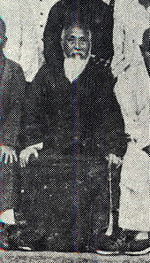Views
Dàojiē 道階 (1866-1934)
|
| Notable Associates: |
Dàojiē 道階 (1866-1934) was one of the first great international monks of the modern period.
Biography
Dàojiē was from Héngshān Township 衡山縣 in Hú'nán. As a youth he studied at a private academy and was quite fond of stories about divine transcendents 神仙. At age 14 he became a vegetarian and at 19 he took tonsure under Zhēnjì 真際 at Zhìshèng Temple 智勝寺 in Héngyáng 衡陽. He was fully ordained the following year at Bàoēn Temple 報恩寺 in Lěihéng 耒衡. After ordination, he went into seclusion at Èrduān Temple 二端寺 on Mt. Shǎn 陝山 for three years to practice Chán 禪. During this time he made the acquaintance of Jìchán 寄禪, one of the most important Chán masters of the late Qing. In the following years, Dàojiē lectured on a variety of scriptures at a number of different temples. In 1901, he accepted an invitation from Jìchán to lecture at Tiāntóng Temple 天童寺 in Níngbō where Jìchán had recently become abbot. There, Dàojiē lectured on the Chéng wéishì lùn 成唯識論, Lotus Sūtra 法華經, and Léngyán (Śūraṃgama) Sūtra 楞嚴經.
In 1907, Dàojiē became one of the first Chinese monks of the modern period to travel to Buddhist sites in South and Southeast Asia. He went to Malaysia, Indonesia, Burma, Thailand, Sri Lanka, and India. In these places he gathered jade Buddha statues, a tooth of the Buddha and other relics, and palm leaf manuscripts. When he returned to China, he became abbot of Hú'nán's Jīnqián Mountain Temple 金錢山寺. He also went to Běijīng 北京 to request a copy of the Qianlong Buddhist Canon (Lóng zàng 龍藏). In 1909, he became a Dharma heir of Zhìguǒ 智果, the abbot of Běijīng's Fǎyuán Temple 法源寺.
At the start of the Republic, Jìchán asked Dàojiē to participate in the short-lived Chinese Buddhist General Association 中華佛教總會. In 1915, he went back to Hú'nán, where he served as the abbot of a number of different temples. He returned to be abbot of Fǎyuán Temple in 1920. He held ordinations there in 1921. Ordinands at that ceremony who went on to have distinguished careers included Fǎfǎng 法舫 and Fǎzūn 法尊.
In 1925, Dàojiē was part of the Chinese delegation to the East Asian Buddhist Conference 東亞佛教大會 in Japan. The delegation also included Tàixū 太虛, Wáng Yìtíng 王一亭, and Hú Zǐhù 胡子笏. In Japan, Dàojiē was named vice-chief of the conference. After the conference, Dàojiē toured various Buddhist sites in Japan and Taiwan before returning to the Chinese mainland.
During the chaos of the Northern Expedition, Dàojiē was forced to leave the country. In 1928 he went to Myanmar as a representative of the Chinese Buddhist Association 中國佛教會. After this, he traveled to India again, where he visited the stūpa built by the Maha Bodhi Society in Deer Park. Dàojiē made a vow to build a Chinese temple at that location, which eventually happened thanks to donations made by a Singaporean lay man named Lǐ Jùnchéng 李俊承.
Dàojiē died on March 15, 1934 in Malaysia. His relics are housed at Fǎyuán Temple in Běijīng.
Notable Students
References
- Shì Dōngchū 釋東初. Zhōngguó Fójiào jìndài shǐ 中國佛教近代史 (A History of Early Contemporary Chinese Buddhism), in Dōngchū lǎorén quánjí 東初老人全集 (Complete Collection of Old Man Dongchu), vols. 1-2. Taipei: Dongchu, 1974 Pp. 2.825-828.
- Yú Língbō 于凌波, ed. Xiàndài Fójiào rénwù cídiǎn 現代佛教人物辭典 (A Dictionary of Modern Buddhist Persons), 2 vols. Taipei: Foguang, 2004. Pp. 2.1386b-1388a.
